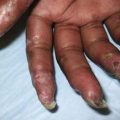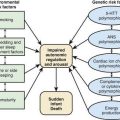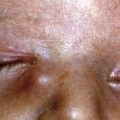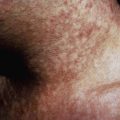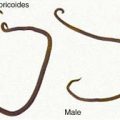Chapter 369 Acquired Disorders of the Nose
369.1 Foreign Body
Complications
Tetanus is a rare complication of long-standing nasal foreign bodies in nonimmunized children (Chapter 203). Toxic shock syndrome is also rare, and most commonly occurs from nasal surgical packing (Chapter 174.2); oral antibiotics should be administered when nasal surgical packing is placed.
Figueiredo RR, Azevedo AA, Kos AO, Tomita S. Nasal foreign bodies: description of types and complications in 420 cases. Rev Bras Otorrinolaringol. 2006;72:18-23.
Glynn F, Amin M, Kinsella J. Nasal foreign bodies in children: should they have a plain radiograph in the accident and emergency? Pediatr Emerg Care. 2008;24:217-218.
Haddad JJr. Foreign bodies of the ear, nose and pharynx. In: Burg FD, Gershon A, Ingelfinger JR, Polin RA, editors. Current pediatric therapy. ed 17. Philadelphia: WB Saunders; 2002:23.
Kiger JR, Brenkert TE, Losek JD. Nasal foreign body removal in children. Pediatr Emerg Care. 2008;24:785-792.
Lin VY, Daniel SJ, Papsin BC. Button batteries in the ear, nose and upper aerodigestive tract. Int J Pediatr Otorhinolaryngol. 2004;68:473-479.
369.2 Epistaxis
Etiology
Common causes of nosebleeds from the anterior septum include digital trauma, foreign bodies, dry air, and inflammation, including upper respiratory tract infections, sinusitis, and allergic rhinitis (Table 369-1). There is often a family history of childhood epistaxis. Nasal steroid sprays are commonly used in children, and their chronic use may be associated with bleeding. Young infants with significant gastroesophageal reflux into the nose rarely present with epistaxis secondary to mucosal inflammation. Susceptibility is increased during respiratory infections and in the winter when dry air irritates the nasal mucosa, resulting in formation of fissures and crusting. Severe bleeding may be encountered with congenital vascular abnormalities, such as hereditary hemorrhagic telangiectasia (Chapter 426.3), varicosities, hemangiomas, and, in children with thrombocytopenia, deficiency of clotting factors, particularly von Willebrand disease, hypertension, renal failure, or venous congestion. Nasal polyps or other intranasal growths may be associated with epistaxis. Recurrent, and often severe, nosebleeds may be the initial presenting symptom in juvenile nasal angiofibromas, which occur in adolescent boys.
Table 369-1 COMMON CAUSES OF EPISTAXIS
From Kucik CJ, Clenney T: Management of epistaxis, Am Fam Physician 71(2):305–311, 2005.
Treatment
In patients with severe or repeated epistaxis, blood transfusions may be necessary. Otolaryngologic evaluation is indicated for these children and for those with bilateral bleeding or with hemorrhage that does not arise from the Kiesselbach plexus. Hematologic evaluation (for coagulopathy and anemia), along with nasal endoscopy and diagnostic imaging, may be needed to make a definitive diagnosis in cases of severe recurrent epistaxis. Replacement of deficient clotting factors may be required for patients who have an underlying hematologic disorder (Chapter 470). Profuse unilateral epistaxis associated with a nasal mass in an adolescent boy near puberty might signal a juvenile nasopharyngeal angiofibroma. This unusual tumor has also been reported in a 2 yr old and in 30-40 yr olds, but the incidence peaks in adolescent and preadolescent boys. CT with contrast medium enhancement and MRI are part of the initial evaluation; arteriography, embolization, and extensive surgery may be needed.
Burton MJ, Doree CJ: Interventions for recurrent idiopathic epistaxis (nosebleeds) in children. Cochrane Database Syst Rev (1):CD004461, 2004.
Calder N, Kang S, Fraser L, et al. A double-blind randomized controlled trial of management of recurrent nosebleeds in children. Otolaryngol Head Neck Surg. 2009;140:670-674.
Kucik CJ, Clenney T. Management of epistaxis. Am Fam Physician. 2005;71:305-311.
Makura ZG, Porter GC, McCormick MS. Paediatric epistaxis: Alder Hey experience. J Laryngol Otol. 2002;116:903-906.
McIntosh N, Mok JYQ, Margerison A, et al. The epidemiology of oro-nasal haemorrhage and suffocation in infants admitted to hospital in Scotland over 10 years. Arch Dis Child. 2010;95:810-816.
Paranjothy S, Fone D, Mann M, et al. The incidence and aetiology of epistaxis in infants: a population-based study. Arch Dis Child. 2009;94:421-424.
Schlosser RJ. Epistaxis. N Engl J Med. 2009;360:784-789.
Wurman LH. Epistaxis. In: Gates GA, editor. Current therapy in otolaryngology—head and neck surgery. ed 5. St Louis: Mosby; 1994:354.


